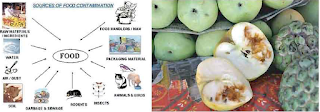1. Warm up activity:
Share the following questions with your friend.
a. What is food adulteration?
b. Have you heard the name of a pesticide called formalin which is used as a preservative?
c. Who, do you think, uses chemical pesticides on food/fruits?
2. Read the following feature item published in a Dhaka daily.
Unsafe levels of pesticides are present in around half of the vegetables and more than a quarter of fruits sold in the capital's markets, a recent survey has found. A 15-member team of the National Food Safety Laboratory, with support from the Food and Agriculture Organisation (FAO), came up with the findings after collecting and testing food samples from the capital's Gulshan, Karwanbazar and Mohakhali markets.
The survey report, a copy of which was acquired by the Dhaka Tribune, read that nearly 40% of 82 samples of milk, milk products, fish, fruits and vegetables contained banned pesticides such as DDT, Aldrin, Chlordane and Heptachlor. The amounts of pesticide in these samples were found to be 3 to 20 times greater than the limits set by the European Union. Around 50% vegetables and 35% fruits were found to be contaminated with unsafe level of pesticides.
Analysing more than 30 samples of turmeric powder (branded, packaged and open), the team also found that nearly 30% of the samples contained traces of lead chromate, which can be fatal if swallowed or inhaled. These samples also contained lead at 20 to 50 times above the safety limit of 2.5 parts per million set by the Bangladesh Standard Testing Institute (BSTI). Arsenic and chromium above safety limits were detected in a total of 5 out of 13 rice samples.
Using a sensitive High-Performance Liquid Chromatography (HPLC) method developed by the Food Safety Lab, 66 samples were analysed for the presence of formaldehyde. Adulteration was thereby detected in samples of coriander, mango and fresh shrimps.
The tests indicated that poultry feed in the country had also been contaminated, as samples of chicken and fish contained traces of antibiotics. High microbial populations were found in several samples of pasteurised milk, indicating poor processing procedures by the manufacturers. Samples of cucumber and street foods also showed high microbial populations, suggesting widespread contamination in the water supply. The Director of Institute of Public Health (IPH), told the Dhaka Tribune that the survey report has been submitted to the Health Ministry. Further tests of different products were being carried out at the Food Safety Lab.
A former Director General of the Health Services and senior national adviser of the FAO, said the findings were shocking for the whole nation. He added that instead of focusing only on the end products, the issue should be addressed at the root level. Pointing out that there were four steps in the production process-farmer, transport, wholesale, and retail trader, -he said better monitoring and supervision were mandatory for stopping food adulteration.
Adulterated food products are reportedly the cause behind thousands of people suffering from fatal diseases like cancer, kidney failure and heart problems. Health specialists told the Dhaka Tribune that the Ministry of Food had enacted a Food Safety Act, but was yet to prepare the necessary rules. As the issue of food safety was also linked to 14 other ministries, a coordinated agency should take responsibility of ensuring safety in food products, they added.
[Adapted from a news published in Dhaka Tribune]
3. Choose the right answer:
a. What percentages of the milk samples contained pesticide?
i. 60
ii. 45
iii. 40
iv. 50
b. How did the scientists realize that the water supply was contaminated?
i. because of microbial presence
ii. from the color of the water
iii. from an analysis of the mineral content
iv. through chemical test
c. Why were microbial populations present in pasteurised milk?
i. because of widespread contamination in the water cows drink
ii. because of the formaldehyde content in the milk
iii. because of poor processing of the milk
iv. all of the above
d. The amounts of pesticide in local food samples are times greater than the limits set by the European Union.
i. 3
ii. 20
iii. 3-32
iv. 60
e. How many ministries are concerned with the food safety issue?
i. 10
ii. 15
iii. 1
iv. 14
4. Answer the following questions:
a. What does 'new height' refer to in the title of the news report?
b. What confirms that even our poultry products are contaminated?
c. What are the health risks related to adulterated food?
d. What is the current state of the Food Safety Act?
5. With a friend, discuss the observation made by the former Director General of Health Services. Is it enough to keep an eye on end products? Make a list of things that you can do to monitor and supervise the production process.
6. Write a letter to the editor of a national daily pointing out the problems of food adulteration in your locality. Or, write a response to this news item published in Dhaka Tribune.
7. Match the words in Column A with their meanings in
Column B in the box below:
Column A
|
Column B
|
i.
pasteurised
|
a.
pertaining to, or characteristic of a microbe
|
ii. banned
|
b. made impure by contact or mixture with something
unclean.
|
iii.
contaminated
|
c. the process of heating (milk) to a
high temperature and then quickly cooling it before
bottling or packaging to make it free from bacteria
|
iv.
populations
|
d.
compulsory
|
v. end
product
|
e. which is produced as the final result of an
activity or process
|
vi.
mandatory
|
f.
prohibited
|
vii.
microbial
|
g. organisms of the same group or species
|
If you want to read the next lesson of this unit please click the link below:













No comments:
Post a Comment